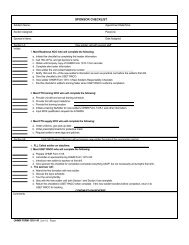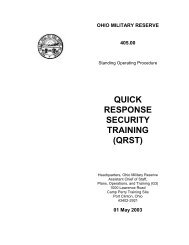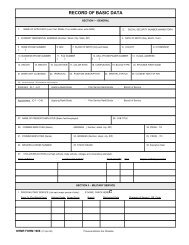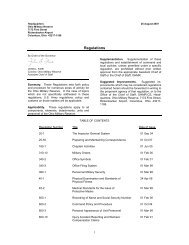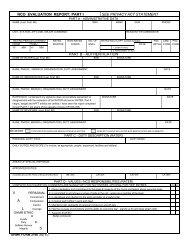physical examination and standards of physical fitness
physical examination and standards of physical fitness
physical examination and standards of physical fitness
- No tags were found...
You also want an ePaper? Increase the reach of your titles
YUMPU automatically turns print PDFs into web optimized ePapers that Google loves.
4) Repeated attacks <strong>of</strong> catarrhalotitis media; intact grayish, thickeneddrum(s).f. Tympanic membrane1) Any perforation <strong>of</strong> the tympanicmembraneg. Any defects <strong>of</strong> the ear which obviouslypreclude satisfactory performance <strong>of</strong>military duty or which require frequent <strong>and</strong>prolonged treatment.2-4. Hearing. Hearing acuity level by whisperedor spoken voice test hearing less than8/15 bilateral; or less than 15/15 in one ear<strong>and</strong> less than 8/15 in one ear.2-5. Upper extremities.a. Limitation <strong>of</strong> motion - an individualwill be unacceptable if the joint ranges <strong>of</strong>motion are less than:1) Shoulder.a) Forward elevation to 90degrees.b) Abduction to 90 degrees.2) Elbow.a) Flexion to 100 degrees.b) Extension to 15 degrees.3) Wrist: Total range <strong>of</strong> 15 degrees(extension plus flexion).4) H<strong>and</strong>.a) Pronation to the first quarter <strong>of</strong>the normal arc.b) Supination to the first quarter <strong>of</strong>the normal arc.5) Fingers.a) Inability to clench fingers.b) With remaining fingers,inability to pick up a pin or needle <strong>and</strong> tograsp an object.b. H<strong>and</strong> <strong>and</strong> fingers: scars <strong>and</strong> deformities<strong>of</strong> the fingers <strong>and</strong>/or h<strong>and</strong> which1) impair circulation,2) are symptomatic,3) draw attention away from amilitary appearance4) or impair normal function tosuch a degree as to interfere with the satisfactoryperformance <strong>of</strong> dutyc. Wrist, forearm, elbow, arm, <strong>and</strong>shoulder: healed disease or injury <strong>of</strong> abovewith residual weakness <strong>of</strong> or symptoms <strong>of</strong>such a degree as to preclude satisfactoryperformance <strong>of</strong> duty.2-6. Lower extremities.a. Limitation <strong>of</strong> motion: an individualwill be considered unacceptable if the jointranges <strong>of</strong> motion are less than:1) Hip.a) Flexion to 90 degrees.b) Extension to 10 degrees (beyond 0).2) Knee.a) Full extension.b) Flexion to 90 degrees.3) Ankle.a) Dorsiflexion to 10 degrees.b) Plantar flexion to 10 degrees.4) Toes: Stiffness which interfereswith walking, marching, running, or jumping.b. Foot <strong>and</strong> ankle. Abscess, scar ordeformity which impairs normal function suchthat running <strong>and</strong> jumping are precluded orwhich interferes with the satisfactory performance<strong>of</strong> military duty.c. Leg, knee, thigh, <strong>and</strong> hip.1) Dislocated semilunar cartilage,loose or foreign bodies within the knee joint, orhistory <strong>of</strong> surgical correction <strong>of</strong> same ifa) within the preceding six (6)months.b) six months or more haveelapsed since operation without recurrence<strong>and</strong>(1) there is instability <strong>of</strong> theknee ligaments in lateral or anteroposteriordirections in comparison with the normal kneeor abnormalities noted on x-ray or,(2) there is significant atrophyor weakness <strong>of</strong> the thigh musculature incomparison with the normal side or,(3) there is not acceptableactive motion in flexionor extension, or(4) there are other symptoms<strong>of</strong> internal derangement.2) Authentic history or <strong>physical</strong>findings <strong>of</strong> an unstable or internally derangedjoint causing disabling pain or seriously limitingfunction. individuals with verified episodes<strong>of</strong> buckling or locking <strong>of</strong> the knee who havenot undergone satisfactory surgical correctionor if, subsequent to surgery, there is evidence<strong>of</strong> more than mild instability <strong>of</strong> the knee ligamentsin lateral <strong>and</strong> anteroposterior directionsin comparison with the normal knee, weaknessor atrophy <strong>of</strong> the thigh musculature incomparison with the normal side or, if the individualrequires medical treatment <strong>of</strong> sufficient



